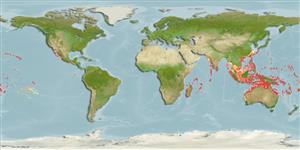>
Eupercaria/misc (Various families in series Eupercaria) >
Scaridae (Parrotfishes) > Sparisomatinae
Etymology: Calotomus: Greek, kalos, kallos = beautiful + Greek, tomos = section, cut (Ref. 45335).
More on author: Valenciennes.
Environment: milieu / climate zone / depth range / distribution range
Ökologie
seewasser riff-verbunden; tiefenbereich 1 - 71 m (Ref. 58302). Tropical; 30°N - 31°S, 30°E - 89°W
Indo-Pacific and Eastern Pacific: widest ranging member of the genus, from East Africa to the Revillagigedo and Galapagos islands. Replaced by Calotomus viridescens in the Red Sea (Ref. 37816). Presence in Somalia to be confirmed (Ref. 30573).
Size / Gewicht / Alter
Maturity: Lm ? range ? - ? cm
Max length : 54.0 cm TL Männchen/unbestimmt; (Ref. 5490)
Rückenflossenstacheln (insgesamt) : 9; Rückenflossenweichstrahlen (insgesamt) : 10; Afterflossenstacheln: 3; Afterflossenweichstrahlen: 9; Wirbelzahl: 25. Grayish brown when fresh with scales with fine whitish markings, shading to brownish red ventrally; head paler ventrally, an indistinct orange-brown line from orbit to upper lip; posterior to orbit, 3 short dull reddish lines. Flexible dorsal spines. Caudal fin rounded in juveniles, double emarginate with slightly prolonged lobes in large males. Skin black around anus. Lateral line interrupted. Brownish red pelvic fins with blotches or spots. Dull reddish-brown iris.
Inhabits subtidal reef flats, and lagoon and seaward reefs to a depths of at least 27 m (Ref. 1602). Found in coral, rubble, seagrass (Ref. 41878, 58302) and weedy areas (Ref. 9710). Benthopelagic (Ref. 58302). Found singly or in small groups (Ref. 9710). Feeds on a variety of benthic encrusting algae, e.g., Padina (Ref. 37816) and seagrasses. A protogynous hermaphrodite which may only have secondary males. Caught with nets and other types of artisanal gear.
Life cycle and mating behavior
Maturities | Fortpflanzung | Spawnings | Egg(s) | Fecundities | Larven
Spawning observed to occur off the reef front on the falling tide at the Aldabra Atoll.
Bruce, R.W. and J.E. Randall, 1985. A revision of the Indo-West Pacific parrotfish genera Calotomus and Leptoscarus (Scaridae: Sparisomatinae). Indo-Pac. Fish. (5):32 p. (Ref. 525)
IUCN Rote Liste Status (Ref. 130435)
Bedrohung für Menschen
Harmless
Nutzung durch Menschen
Fischereien: kommerziell; Aquarium: Kommerziell
Tools
Zusatzinformationen
Download XML
Internet Quellen
Estimates based on models
Preferred temperature (Ref.
123201): 24.7 - 28.7, mean 27.5 °C (based on 664 cells).
Phylogenetic diversity index (Ref.
82804): PD
50 = 0.5312 [Uniqueness, from 0.5 = low to 2.0 = high].
Bayesian length-weight: a=0.01259 (0.01004 - 0.01578), b=3.11 (3.05 - 3.17), in cm total length, based on LWR estimates for this species (Ref.
93245).
Trophic level (Ref.
69278): 2.0 ±0.00 se; based on food items.
Widerstandsfähigkeit (Ref.
120179): mittel, Verdopplung der Population dauert 1,4 - 4,4 Jahre. (Preliminary K or Fecundity.).
Fishing Vulnerability (Ref.
59153): Moderate vulnerability (42 of 100).
Nutrients (Ref.
124155): Calcium = 32.7 [16.7, 106.5] mg/100g; Iron = 0.707 [0.295, 1.658] mg/100g; Protein = 18.8 [16.7, 20.6] %; Omega3 = 0.0819 [, ] g/100g; Selenium = 21.7 [7.4, 57.5] μg/100g; VitaminA = 25.7 [7.3, 94.8] μg/100g; Zinc = 1.96 [0.97, 3.40] mg/100g (wet weight); based on
nutrient studies.
